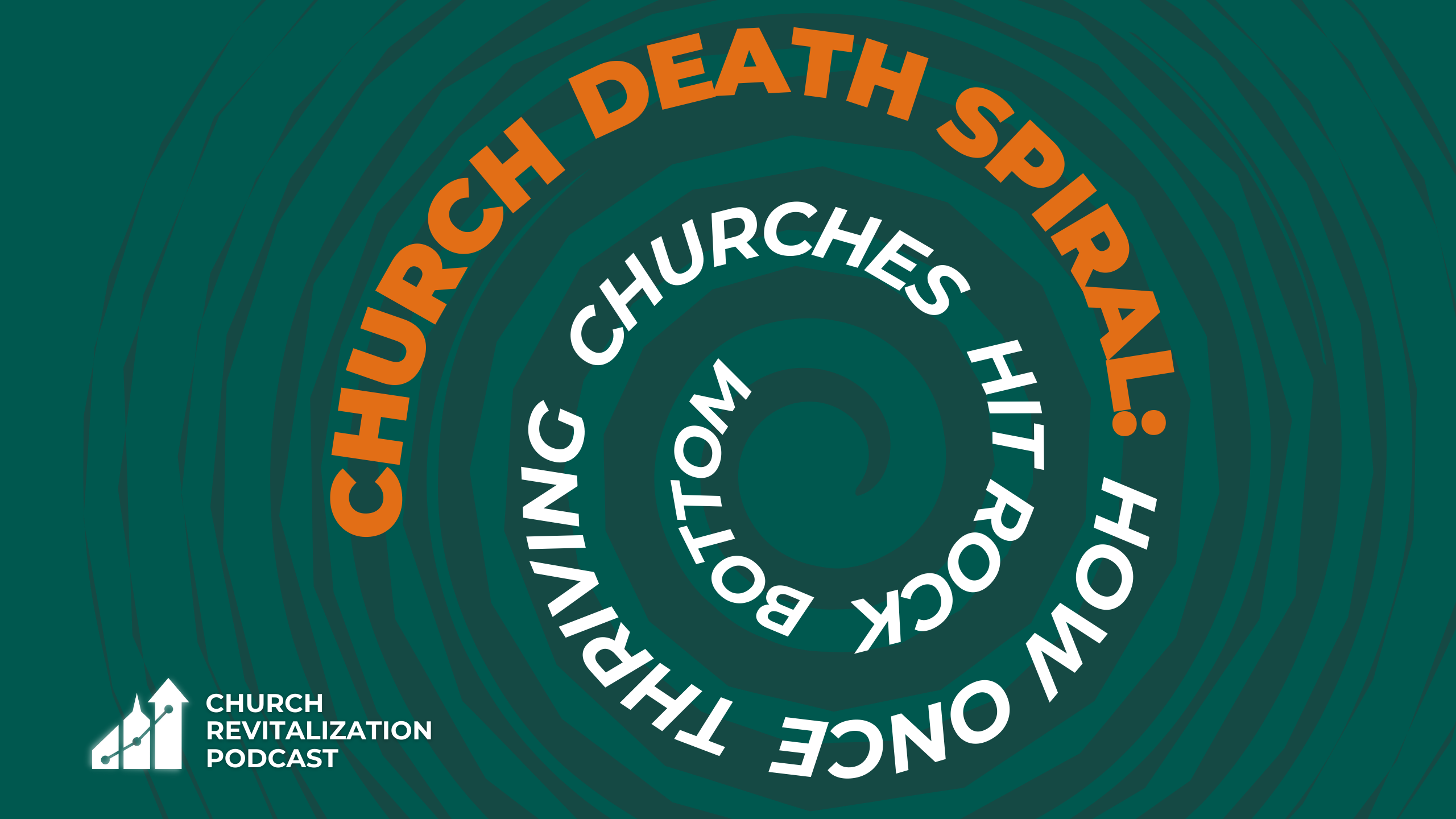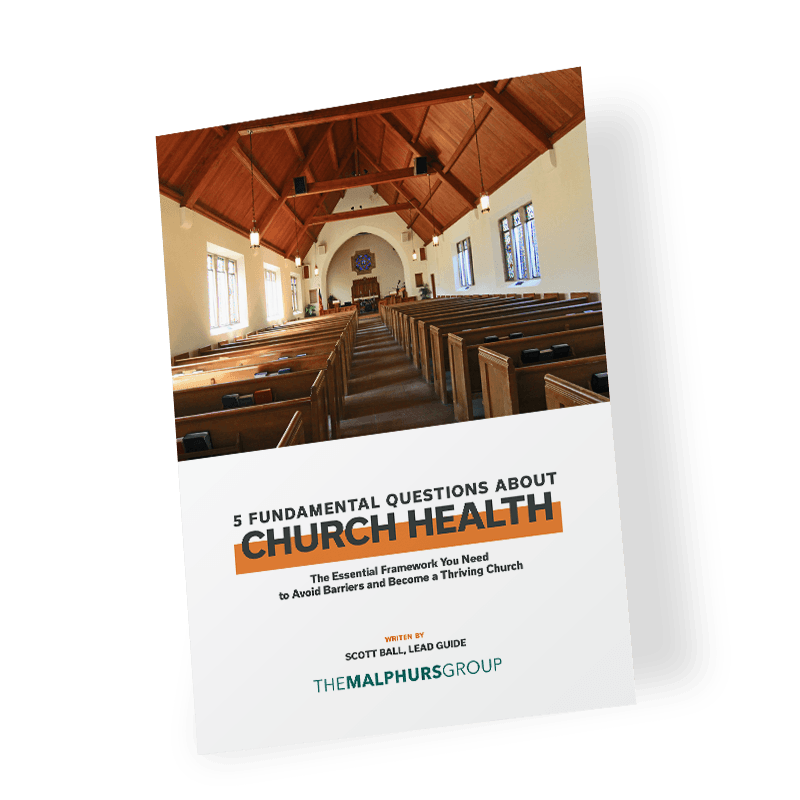The Church Revitalization Podcast – Episode 207
First Community Church once bustled with activity. Families packed the pews each Sunday while kids scurried off to crowded Sunday School classes. The budget was strong enough to maintain their historic building and offer dynamic programming. First Community was widely known as a cornerstone of faith in their town.
But over time, things changed. Attendance declined slowly as members moved away or transferred to other churches. Facilities started to show their age. Programs stayed the same even as the community evolved. Year after year, First Community slid further from its former vibrancy.
First Community found itself in a church “death spiral” – stuck in a cycle of slow, steady decline. Their story is all too common. Once-thriving churches coast on momentum until stagnation gives way to deterioration. Decline often accelerates gradually before hitting a crisis point.
It’s an all-to-common scenario that we deal with frequently. As we engage with churches through our Strategic Envisioning and Leadership Pipeline Design work to help them move back into growth positions, we see several recurring causes of the decline.
Subscribe below to never miss an episode.
Cause: Infrastructure/Maintenance Issues
As churches age, deferred maintenance often accelerates decline. Shabby facilities communicate that the church is stuck in the past. Broken sound systems, uncomfortable chairs, dirty carpets, and outdated children’s areas all contribute to a poor first impression. Guests perceive that the church lacks vision and doesn’t care about excellence.
Compounding this issue is that maintenance costs continue to increase as buildings and equipment age. Budgets strained by rising maintenance expenses have fewer resources for mission and ministry. The weight of burdensome facilities can demoralize members and staff.
The key solution is to create and implement a Master Facilities Plan. Audit the condition of all buildings and grounds. Project future maintenance costs. Consider the highest and best use of facilities based on your vision and demographic trends. Then craft a 3-5 year plan to upgrade, renovate, or build new facilities aligned with your church’s needs and vision for ministry. share the plan to build excitement and commitment.
Cause: Lack of Community Engagement and Outreach
One of the most common causes of church decline is moving away from an external focus. Jesus didn’t say, “Stay and maintain the disciples you already have,” he said, “Go and make disciples of all nations.”
Outward-focused churches both demonstrate and communicate who Jesus is. They truly care. They follow the commands of Christ. They are the body of Christ in action. They take the time to understand who is in their “Jerusalem” (Acts 1:8) and then they seek to align what their strengths and resources are to the needs of the people closest to them. That’s where their greatest impact can happen. They don’t copy and paste what other churches are doing. They do the work and put in the creative effort to make a difference in people’s lives.
The solution is to think like a missionary. If you were going into an unknown place to start a church, how would you deal with the people you were trying to reach? That same mindset must be applied to your current city.
Cause: Lack of Guest Focus and Assimilation
Once decline begins, churches often lose focus on guests. The further down the spiral, the less frequently guests will even show up, which continues to build into the idea that there is no need to be guest-ready.
One of the first things a guest may notice is that the church was not prepared for them to have arrived. No greeters at all or apathetic greeters become common and play a large role in a guest’s first impressions. When it’s not obvious or easy to find information about activities, getting connected or learning more about the church from friendly, welcoming people, guests are likely to not return.
Welcoming people, engaging with them, inviting them to take another step with you, and then getting them into your discipleship pathway is a process, not an event. It must be well thought out and executed in order to see it work.
Cause: Leadership Stagnation and Burnout
Long-tenured leaders who become complacent and resistant to change contribute to church decline. Over time, the same group of leaders can become insular and disconnected from the wider congregation and community. They lean on “this is how we’ve always done it” rather than innovating and taking risks.
Additionally, without an intentional leadership pipeline, emerging leaders lack mentoring and opportunities to step up. This leads to frustration and stagnation. Leaders already serving frequently burn out from a lack of shared workload. They start to model dissatisfaction and pessimism rather than passion.
The key solution is to create an effective leadership pipeline. Identify and recruit emerging leaders to be trained to take on greater responsibility. Empower mid-level leaders to take ownership of new ministries aligned with the church’s vision. Break big roles into smaller, sustainable positions to engage more people and prevent burnout. Use term limits to gracefully transition seasoned leaders out of roles to make space for new leaders.
You cannot say you care about the next generation unless you care about every generation and continuously help move people into leadership and decision-making roles.
Cause: Ineffective at Growing Disciples
Many declining churches have lots of programs but little discipleship. Members remain stagnant in spiritual maturity because the teaching lacks depth, and the church lacks a pathway for purposeful spiritual growth. Consequently, members live compartmentalized lives disconnected from their faith.
The foremost solution is to streamline ministries through the lens of a discipleship pathway. Evaluate all programs based on their contribution to spiritual growth based on a set of biblical values as foundational. Prune and combine ministries into essential building blocks that intentionally develop maturity. Define expectations for what disciples should know, believe, and do at each stage. Equip leaders to foster spiritual growth within each ministry. A comprehensive discipleship pathway aligns all ministries to the shared goal of maturity in Christ.
Church decline does not happen overnight, nor will revitalization be immediate. However, with humility, urgency and consistent action, leaders can steer churches away from the “death spiral.” Begin with an honest assessment and willingness to change. Cast a vision that rallies people to a better future. With God’s help and by His grace, your church can thrive again.
The road is long, but the first steps are simple – acknowledge warning signs, seek wise counsel, and act boldly. Streamline ministries to focus on discipleship and outreach. Make facilities welcoming and functional again. Rejuvenate leadership with fresh faces and new energy. Decline is not inevitable – with concerted effort and dependence on God, your best days can be ahead. There is always hope for restoration!
Watch this episode on YouTube


A.J. Mathieu is the President of the Malphurs Group. He is passionate about helping churches thrive and travels internationally to teach and train pastors to lead healthy disciple-making churches. A.J. lives in the Ft. Worth, Texas area, enjoys the outdoors, and loves spending time with his wife and two sons. Click here to email A.J.

